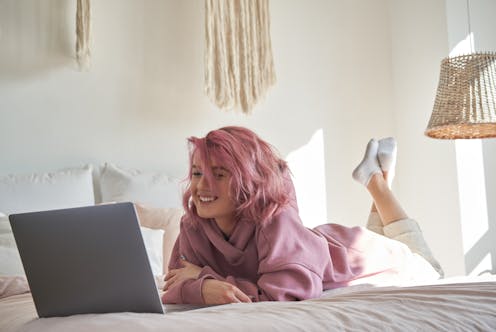what Aussie teenagers told us about not watching local TV
- Written by Phoebe Macrossan, Lecturer in Screen Media, University of the Sunshine Coast

Australian teenagers have grown up with abundant choices in digital screen entertainment including social media, gaming and streaming video.
However, the viewing habits of Australian teens are often overlooked in research. The most recent report[1] from the Australian Communications and Media Authority into the digital lives of “younger Australians” does not include teens, with the lowest demographic aged 18–24.
The lack of teen audience studies in Australia is significant. Young children and teenagers are a distinctive and growing market, and a highly attractive audience for global streamers.
Our new study[2] investigated how, why and to what extent Australian teenagers aged 13 to 19 engage with long-form TV drama and movies in their daily lives, including Australian stories.
We found Australian teens overwhelmingly preferred to watch streaming services like Netflix, Disney+, Amazon Prime, Stan and YouTube over free-to-air television. Their tastes are broad and include shows such as Heartstopper[3] and The Summer I Turned Pretty[4].
But teens aren’t watching much Aussie content.
Aussie teens don’t watch Aussie content
Although many remember the Australian TV they watched as children with affection, teens now place a low priority on a screen story being Australian.
When we asked survey participants why they like the streaming services they regularly watch, 33% of participants ranked access to Australian content last and 25% ranked it second last, out of six options. For teens, the most important streaming feature was being able to watch a whole season on demand.
Several teens said they do not watch or desire to watch Australian content.
One teen told us:
I don’t really want to watch shows that are about Australia. I just feel like I pretty much already know what Australia’s like.
Many teens did have fond memories of watching Australian TV as a child. They listed shows like Home and Away (Seven), Nowhere Boys (ABC), Kath & Kim (ABC and then Seven), H₂O: Just Add Water (Network 10), Mako Mermaids (Network 10), Summer Heights High (ABC) and Koala Brothers (ABC).
But they didn’t always classify these shows as “Australian”. One participant told us “I don’t watch anything Australian”, but then called H₂O “my favourite TV show on the whole planet!”
A love for Heartbreak High
Netflix’s 2022 Australian reboot of Heartbreak High was a marked exception to teens’ general lack of engagement with Australian content.
Originally broadcast in the 1990s, Netflix released a reboot of Heartbreak High[5] in September 2022 during the middle of the data collection for this project.
As a recent release on a major streamer that remained in Netflix’s top 10[6] for its first three weeks, Heartbreak High was a common talking point for many teens. They were particularly drawn to the characters, and representations of neurodivergence, sexuality, gender and ethnicity.
During one focus group discussion, one participant praised the character of Quinni (Chloe Hayden) and how on the show:
they actually represent how autistic people are through their day-to-day lives.
Another said:
I like how there were First Nations people […] [It’s not] just all white Australian cast. There’s a diversity.
Teens also enjoyed listening to Australian accents and familiar vernacular used in the show, such as “bin chickens” referring to the urban scavenging bird, the ibis.
Similarly, they laughed at “eshay”: a common slang term in Australia for a male working-class youth subculture, associated with sports brands, disruptive behaviour and crime. Participants enjoyed the construction of “eshay” character Ca$h (Will McDonald), who they felt was humanised and disrupted classist stereotypes.
Do we need quotas?
Historically, Australian governments have valued[7] domestically produced drama and children’s programs as a means of socialising and uniting Australian viewers, particularly young audiences.
Broadcasting policies from the late 1970s compelled Australia’s three commercial broadcasters to annually provide[8] 130 hours of new Australia children’s content, including 32 hours of drama.
In 2021 however, the Morrison government removed all children’s quota obligations from commercial broadcasters. By 2024 their investment in children’s drama had fallen to zero[9]. This policy development left the ABC largely responsible for children’s television in Australia, but the ABC does not currently make any television specifically for young people older than 12[10] that is, the teen audience.
There is no political appetite for bringing back children’s quotas on free-to-air channels, but even if quotas were re-introduced, this isn’t where young people are looking to watch television. Of our survey respondents, 12.6% said they “never” watched free-to-air television, 28% said they “rarely” did, 25% watched “sometimes”, and only 10% watched free-to-air channels “mostly” or “always”.
When we expanded this to look at the streaming services of these channels, like ABC iView, SBS On Demand and 10Play, still only 27% “sometimes”, and 9% “mostly” and “always”, watched on these platforms.
Streamers like Netflix and Stan are exempt from Australian content regulations. The Australian government has pledged to introduce[12] regulations for streamers from July 1, but is yet to table a motion in parliament or provide much detail on what that might look like. It is unclear if there would be specific quotas for children or any formal protections for distinctively Australian stories.
If and when these quotas are re-introduced, putting quotas on any service will not be enough if we’re not talking to Aussie teens about what, where and how they watch – and understanding the shows they will want to watch in the future.
References
- ^ recent report (www.acma.gov.au)
- ^ study (journals.sagepub.com)
- ^ Heartstopper (www.netflix.com)
- ^ The Summer I Turned Pretty (www.primevideo.com)
- ^ Heartbreak High (theconversation.com)
- ^ top 10 (www.theguardian.com)
- ^ have valued (blog-actf.com.au)
- ^ annually provide (www.acma.gov.au)
- ^ fallen to zero (tvtonight.com.au)
- ^ young people older than 12 (www.abc.net.au)
- ^ oatawa/Shutterstock (www.shutterstock.com)
- ^ pledged to introduce (www.theguardian.com)

















